
Xylomelum is a genus of six species of flowering plants, often commonly known as woody pears, in the family Proteaceae and are endemic to Australia. Plants in this genus are tall shrubs or small trees with leaves arranged in opposite pairs, relatively small flowers arranged in spike-like groups, and the fruit a woody, more or less pear-shaped follicle.

Lambertia multiflora, commonly known as many-flowered honeysuckle, is a multi-stemmed shrub which is endemic to the south-west of Western Australia. It grows to between 0.5 and 2.5 metres high and flowers from winter to summer.

Lambertia ericifolia , commonly known as heath-leaved honeysuckle, is a shrub which is endemic to the south-west of Western Australia. It grow up to 5 metres high and has orange to red flowers which appear from spring to autumn.

Elattostachys is a genus of about 21 species of trees known to science, constituting part of the plant family Sapindaceae.

Archontophoenix is a plant genus comprising six palm species that are native to New South Wales and Queensland in eastern Australia. They are tall, slender and unbranched. Relationships between Archontophoenix and the other genera of subtribe Archontophoenicinae, including the New Caledonia endemic Actinokentia, Chambeyronia and Kentiopsis are unresolved.
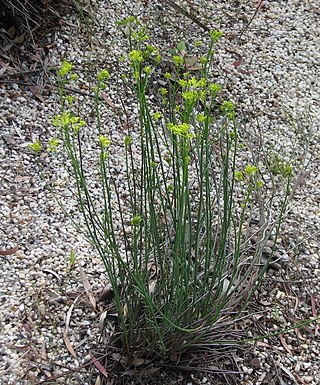
Glischrocaryon is a genus of flowering plants in the family Haloragaceae, endemic to Australia. Species occur in New South Wales, Victoria, South Australia and Western Australia include:
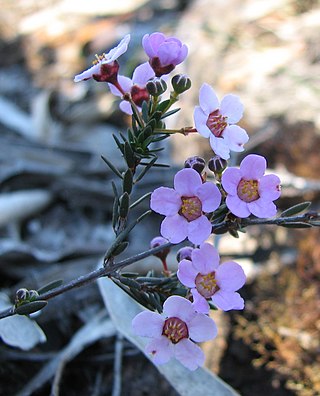
Euryomyrtus is a genus of shrubs, in the family Myrtaceae, all of which are endemic to Australia.
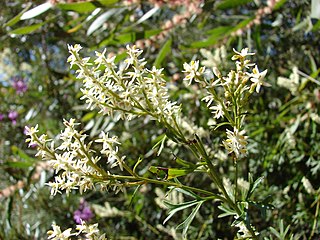
Symphionema is a genus of two species of small shrubs in the family Proteaceae. Both species are endemic to New South Wales in Australia.

Aphanopetalum is a genus of twining shrubs or vines in the family Aphanopetalaceae which are endemic to Australia.

Threlkeldia is a genus of annuals or short-lived perennials in the family Amaranthaceae. There are two species, both of which are endemic to Australia. Together they occur in all Australian states except Queensland.

Lambertia formosa, commonly known as mountain devil, is a shrub of the family Proteaceae, endemic to New South Wales, Australia. First described in 1798 by English botanist James Edward Smith, it is the type species of the small genus Lambertia. It is generally found in heathland or open forest, growing in sandstone-based soils. It grows as a multistemmed shrub to around 2 m (7 ft) with a woody base known as a lignotuber, from which it regrows after bushfire. It has stiff narrow leaves, and the pink to red flowerheads, made up of seven individual tubular flowers, generally appear in spring and summer. It gains its common name from the horned woody follicles, which were used to make small devil-figures.

Burchardia is a genus of herbs that are endemic to Australia. The genus is named for Johann Heinrich Burkhardt, a German botanist.
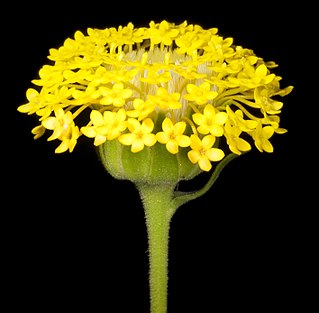
Podotheca is a genus of flowering plants in the tribe Gnaphalieae within the family Asteraceae. All species are endemic to Western Australia, except for Podotheca angustifolia which occurs across the south of Australia.

Lambertia inermis, Noongar chittick, is a shrub which is endemic to south-west Western Australia. It grows to 6 metres high and flowers from spring to winter. A more complete description is given in Florabase and Australian Flora online.
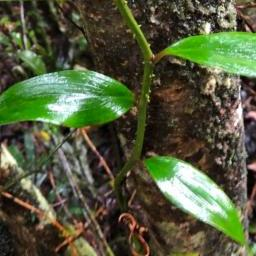
Petermannia is the sole genus of plants in the family Petermanniaceae. Petermannia cirrosa, the only species in the genus, is endemic to the states of New South Wales and Queensland in Australia. it is a prickly, wiry stemmed vine which grows to 6 metres in height and has lancelote, ovate or elliptic leaves with an acute apex. The flowers, which appear during summer, have reflexed reddish green or white tepals. These are followed by rounded red berries.
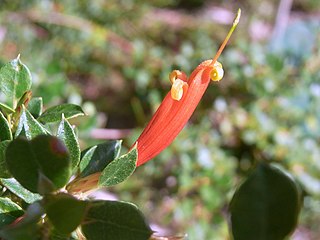
Lambertia uniflora is a shrub in the family Proteaceae. Endemic to the moist south-west corner of Western Australia, it grows to 3 metres in height. Single axillary or terminal flowers appear between October and January in the species' native range. These are orange or red with a yellow or yellow-green limb. This species first appeared in the scientific literature in 1810, authored by the prolific Scottish botanist, Robert Brown.

Codonocarpus is a small genus of shrubs or small trees in the family Gyrostemonaceae.

Lambertia orbifolia, commonly known as the roundleaf honeysuckle, is a shrub or small tree that is endemic to the south-west of Western Australia. It has more or less circular leaves and groups of between four and six orange-red flowers.

Lambertia rariflora, commonly known as green honeysuckle, is a shrub which is endemic to the south-west of Western Australia.
Lambertia fairallii, commonly known as Fairall's honeysuckle, is a shrub which is endemic to the south-west of Western Australia.



























